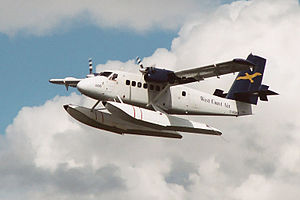De Havilland Canada DHC-6 Twin Otter

The DHC-6 Twin Otter is a 20-seat STOL feederliner and utility aircraft developed by de Havilland Canada. It is often called the most successful aircraft program in Canada's history.
Development of the aircraft began in 1964, with a first flight on May 20, 1965. The enhanced reliability and performance of twin engines made it an immediately popular alternative to the Single Otter which had been flying since 1951. Twin Otters could be delivered with floats, skis, or tricycle landing gear direct from the factory, and they became popular bush planes in Alaska and northern Canada. Also used for MEDEVACs and cargo, many Otters still serve in the far north, but they can also be found in Africa, Australia, Antarctica, and other regions where bush planes are preferred. Their versatility and maneuverability have made them popular in areas with difficult flying conditions, including Papua New Guinea.
The first aircraft produced were designated Series 100s. In 1968, the 200 series improved the STOL performance as well as adding a sharper, longer nose (except when fitted with floats) and reconfigured rear storage compartment. These proved much more popular, and within a year 115 had been sold — equal to the number of 100 Series airframes. The 1969 300 series followed quickly, further increasing performance by adding more powerful PT6A-27 engines. This would prove the most successful variant by far, with 614 airframes sold before production ended in 1988.
The aircraft's fixed tricycle undercarriage, STOL abilities and relatively high rate of climb have made it popular with commercial skydiving operations where it is generally limited to carrying 22 jumpers (a relatively large load compared to most other aircraft in the industry).
Gallery
-
Landing on the beach at Barra Airport
-
DHC-6 Twin Otter on skis. This is a -300 model with the short-nose option
-
A Twin Otter in Antarctica
-
Search and Rescue Twin Otter
-
A Twin Otter used for parachuting
-
Coast Guard Twin
Specifications (300 series)

General characteristics
- Crew: 2
- Capacity: 13-18 passengers (early models), 20 passengers (later models)
- Length: 51 ft 9 in( 15.77 m)
- Wingspan: 65 ft (19.8 m)
- Height: 19 ft 6 in 5.9 m)
- Wing area: 420 ft² (39 m²)
- Empty: 7,415 lb (3,363 kg)
- Loaded:
- Maximum takeoff: 12,500 lb (5,670 kg)
- Powerplant: 2 x PT6A-27 turboprops, 620 hp (460 kW)
- US Military Designation: UV-18 / V-18
Performance
- Maximum speed: 182 knots (338 km/h)
- Ferry Range: 920 nautical miles (1,705 km)
- Service ceiling: 26,700 ft (8,140 m)
- Rate of climb: 1600 ft/min (8.1 m/s)
- Wing loading: kg/m² ( lb/ft²)
- Power/mass: hp/lb ( kW/kg)
Military Operators
- Argentina (Air Force, Army, Navy), Afghanistan, Australia, Benin, Canada, Chile, Colombia, Ecuador, Ethiopia, France (Air Force, Army), Haiti, Jamaica, Nepal, Norway, Panama, Paraguay, Peru, Sudan, Uganda, United States (Air Force, Army)
Related content
Related development
Aircraft of comparable role, configuration, and era
- Antonov An-2
- Antonov An-28
- Fairchild Dornier 228
- GAF Nomad
- Harbin Y-12
- IAI Arava
- LET L-410
- Shorts SC.7 Skyvan


